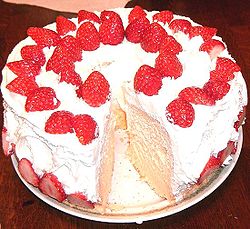Chiffon cake
 Chiffon cake with strawberries | |
| Type | Cake |
|---|---|
| Place of origin | United States |
| Created by | Harry Baker |
| Main ingredients | Flour, vegetable oil, eggs, sugar |
A chiffon cake is a very light cake made with vegetable oil, eggs, sugar, flour, baking powder, and flavorings. It is a combination of both batter and foam type (sponge type) cakes.
Instead of the traditional cake ingredient butter or paste (such as shortening), vegetable oil is used; but this is difficult to beat enough air into. Therefore, chiffon cakes, like angel cakes and other foam cakes, achieve a fluffy texture by beating egg whites until stiff and folding them into the cake batter before baking. Its aeration properties rely on both the quality of the meringue and the chemical leaveners. Its oil-based batter is initially blended before folding into the meringue.
A chiffon cake is a cross between an oil cake and a sponge cake. It includes baking powder and vegetable oil, but the eggs are separated and the whites are beaten before being folded into the batter creating the rich flavor like an oil cake, but with a lighter texture that's more like a sponge cake. They can be baked in tube pans or layered with fillings and frostings.[1]
Characteristics
The high oil and egg content creates a very moist cake, and as oil is liquid even at cooler temperatures, chiffon cakes do not tend to harden or dry out as traditional butter cakes might. This makes them better-suited than many cakes to filling or frosting with ingredients that need to be refrigerated or frozen, such as pastry cream or ice cream. Chiffon cakes tend to be lower in saturated fat than butter cakes, potentially making them healthier than their butter-heavy counterparts. The lack of butter, however, means that chiffon cakes lack much of the rich flavor of butter cakes
-
Hokkaido cake, a chiffon cupcake that's filled with cream, French Baker (Philippines)
-
Lemon chiffon cake
History
The chiffon cake was invented in 1927 by Harry Baker, a California insurance salesman turned caterer. Baker kept the recipe secret for 20 years until he sold it to General Mills, which spread the recipe through marketing materials in the 1940s and 1950s. The name was changed to "chiffon cake" and a set of 14 recipes and variations was released to the public in a Betty Crocker pamphlet published in 1948.[2]
In popular culture
- In the United States, March 29 is National Lemon Chiffon Cake Day.[3]
See also
References
- ^ Malgieri, Nick. "CAKES: RECIPES AND TIPS". Epicurious. Retrieved 9 October 2015.
- ^ The New Best Recipe. Brookline, MA: America's Test Kitchen. 2004.
- ^ Mollie Stone's Markets Almanac newsletter Volume 4 No 3 March 2013
External links
 Media related to Chiffon cake at Wikimedia Commons
Media related to Chiffon cake at Wikimedia Commons


